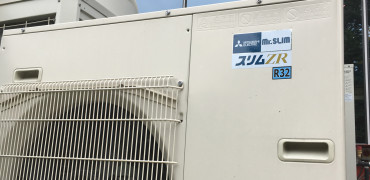As a trainer, I see lots of installers both young and old and I’m still getting questions about the ‘new’ refrigerant, R32, which says to me that some in the industry are yet to embrace the change and the opportunity it brings.
We know there is still a lot of R410A equipment on the market and this will be the case for a few years to come, so there is still good business to be done for installers in the short term.
But looking further ahead, what opportunities to grow your business are you missing out on by not getting to grips with R32?
R32 is rapidly changing the air conditioning market here in the UK
Transitioning market
Certainly when it comes to our big corporate customers, most of them have embraced R32 models because they want to benefit from using equipment with a lower global warming potential (GWP).
In the main, these models are also more efficient, bringing even more performance and benefits to customers. They do this using about 20% less overall refrigerant as well which helps with general installation costs.
This means there will be savings in running costs to benefit from as well – something that customers both large and small can benefit from.
There is now an R32 solution in almost all kinds of RAC and PAC air conditioning systems including our own recently launched Mr Slim Standard Inverter and Inverter models which join the hugely popular R32 Power Inverter units.
Not forgetting the technological advances as well, with indoor units that come with built-in sensors that can detect the temperature of individuals in the room and tailor the air conditioning to suit.
So, there’s little to stop most jobs converting to R32 now with the choice of indoor and outdoor units available.
What about VRF?
For larger systems, R32 has posed technical challenges for most manufacturers and so far, no manufacturer has released a VRF system utilising R32 – with one exception.
The notable exception is our own Hybrid VRF system of course, which uses water as the main heat transfer medium and therefore removes any refrigerant from the vast majority of occupied spaces within buildings.
We’ve had huge interest in this as it still provides the only R32 VRF solution for large scale applications.
Training and support
We’ve been including R32 in our training course for several years now although any F-Gas qualified installer will have the skills necessary to deal with this.
I therefore make a direct appeal to anyone in the industry who has yet to get their head around R32 because they are missing out a growing area of work for their business.
Final thoughts
The introduction of R32 systems is rapidly changing the air conditioning market here in the UK and it affects anyone who uses it, commissions it, designs, installs or maintains it.
This change is therefore coming to a building near you soon, especially as more and more customers realise that they notice little difference – apart from lower carbon emissions, higher efficiency and lower GWP.
So, if you haven’t embraced R32 yet, please sign up for one of our training courses and make sure you are ready.



